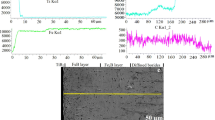Abstract
A simplified test procedure was established to assess the hot-corrosion behavior of MCrAlY-type nickel-base alloys under the influence of molten sodium sulfate as well as sodium sulfate/potassium sulfate salt blends. Salt-coated specimens were exposed to 1-hr thermal cycles at 950°C in flowing oxygen for up to 500 cycles. Mass-change data of the specimens revealed a significant dependence of the corrosion attack not only on the average contaminant flux rate, as expected, but also on the initial amount of salt deposited during each recoating cycle. Furthermore, deposit removal before salt recoating markedly influenced the corrosion attack of the alloys. This was apparently related to changes in salt chemistry by the dissolution of elements such as Cr from the alloy, which can shift the basicity of the salt and thus affect the extent of attack. Substituting Na for K in sodium sulfate/potassium sulfate salt blends generally resulted in decreased attack. For K-containing salt deposits, increasingthe gross amount of alkali compared to sulfur resulted in increased sample weight losses due to scale spallation. In contrast, decreasing the amount of sulfur in such deposits which contained exclusively Na as the alkali resulted in a significantly reduced corrosion attack compared to stoichiometric sodium sulfate.
Similar content being viewed by others
REFERENCES
H. J. Grabke and D. B. Meadowcroft, Guidelines for Methods of Testing and Research in High Temperature Corrosion (The Institute of Materials, London, U.K., 1995).
P. Hancock, Corros. Sci. 22, 51 (1982).
S. R. J. Saunders, Mat. Sci. Technol. 2, 282 (1986).
P. Steinmetz, C. Duret, and R. Morbioli, Mater. Sci. Technol. 2, 262 (1986).
J. R. Nicholls, in Guidelines for Methods of Testing and Research in High Temperature Corrosion, H. J. Grabke and D. B. Meadowcroft, eds. (The Institute of Materials, London, U.K., 1995), p. 11
A. V. Dean, Investigation into the Resistance of Various Ni-and Co-Based Alloys to Sea Salt Corrosion at Elevated Temperatures, National Gas Turbine Establishment, Report (1964).
C. Leyens, I. G. Wright, and B. A. Pint, in Elevated Temperature Coatings: Science and Technology III, J. M. Hampikian and N. B. Dahotre, eds. (TMS, Warrendale, PA, 1999), p. 79.
N. S. Bornstein and W. P. Allen, Mater. Sci. Forum 251-254, 127 (1997).
I. G. Wright, C. Leyens, and B. A. Pint, International Gas Turbine and Aeroengine Congress, München, Germany, 8-11 May 2000, paper 2000-GT-0019, submitted.
D. K. Gupta and D. S. Duvall, A Silicon and Hafnium Modified Plasma Sprayed MCrAlY Coating for Single Crystal Superalloys (TMS, Warrendale, PA, 1984), p. 711.
C. Leyens, I. G. Wright, B. A. Pint, and P. F. Tortorelli, in Cyclic Oxidation of High Temperature Materials, M. Schütze and W. J. Quadakkers, eds. (The Institute of Materials, London, U.K., 1999), p. 169.
R. A. Rapp and Y. S. Zhang, JOM, 47 (1994).
J. A. Goebel, F. S. Pettit, and G. W. Goward, Metall. Trans. 4, 261 (1973).
Y. S. Zhang, J. Electrochem. Soc. 133, 655 (1986).
R. A. Rapp, Mat. Sci. Eng. 87, 319 (1987).
C. Leyens, unpublished research (1998).
Author information
Authors and Affiliations
Rights and permissions
About this article
Cite this article
Leyens, C., Wright, I.G. & Pint, B.A. Effect of Experimental Procedures on the Cyclic, Hot-Corrosion Behavior of NiCoCrAlY-Type Bondcoat Alloys. Oxidation of Metals 54, 255–276 (2000). https://doi.org/10.1023/A:1004698211940
Issue Date:
DOI: https://doi.org/10.1023/A:1004698211940




